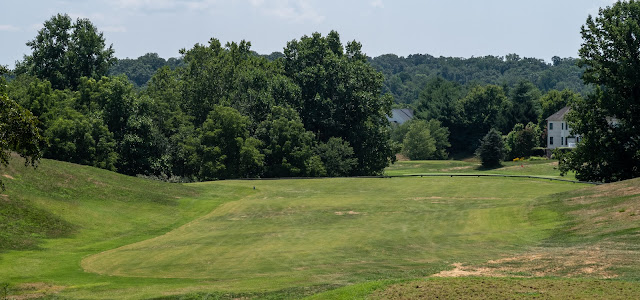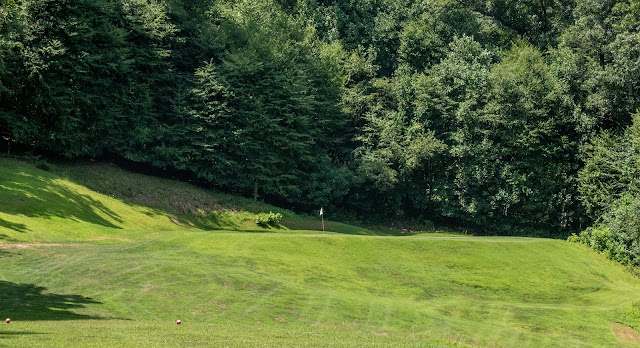There are some golf course architects where, when you look at their work, you have to wonder just how they got hired to build so many courses. Somehow, Arthur Hills was responsible for building over 200 golf courses, all over the world, and while River Downs, located just outside the furthest reaches of Baltimore's northwestern suburbs, is only the third Arthur Hills course I've played, I feel confident in saying this: I have no idea how the guy got so much work.
Maybe he just didn't like Maryland. Maryland National is terrible (though admittedly, that wasn't entirely his fault), Waverly Woods is okay-ish, and River Downs is ... well, I didn't want to go play it because I thought it looked good. Really, all I was hoping for was bad in an entertaining fashion. Did River Downs at least manage that? Let's find out.
The first hole is certainly an auspicious start to proceedings; at 500 yards, it initially seems like a great opportunity to start the round off with a birdie. Then you're confronted with a precipitous downhill tee shot to a fairway bisected by a stream halfway through and you're forced to wonder: "What in the world do I hit on this tee shot?" A yardage is provided on the hole information sign next to the tee, but typically, it's wrong. Either that or I hit a 300-yard 3 wood into an untenable position at the bottom of the hill, behind the cluster of trees to the right. My only option was to pitch 50 yards in the literal wrong direction back to the fairway. This is what some might term "less than ideal."
So, since clearing the stream is out (that is too far), your only real option on the tee is to use an iron. I guess that's one way of making this hole play as a three-shotter. From so far back (and from a steeply downhill stance), this green is pretty much out of reach in two, which means the second shot is kind of boring. Just advance the ball over the stream and you're fine, though if you can favor the left side, that will give you a better angle into the long, narrow green, which has two small bunkers right.
 |
| The first hole. |
 |
| Approaching the first green. |
 |
| The first green. |
At the very least, the second hole is more honest about how far you can hit your tee shot before dropping down into oblivion. It is still another long iron though, which means you'll have something between 150 and 200 yards for your second shot on this 420-yard par 4. Most of which is forced carry to a shallow green with a deep bunker left.
There was a group of golfers ahead of us for the first few holes who were clearly not very good, and there's no way they were able to clear these various ravines on a reliable basis. Only their best shots would do it. And while they might be okay with losing 15 golf balls during a round, that doesn't mean this sort of design is okay. It ruins the rounds of poorer golfers, and for those of us who have no issue carrying a golf ball 150 yards, it just presents an irritation, not an actual hazard.
 |
| The second hole. I think, at this point, you can kind of tell that maintenance here leaves something to be desired. That front tee was an absolute atrocity. |
 |
| Approaching the second green. |
 |
| The second green. |
The third hole is a simple but subtly challenging short par 3, playing 155 yards downhill to a green that slopes from front to back. Holes like this are all about distance control; with the green below you and the inevitable roll your tee shot will get, you need to play this hole a lot shorter than the yardage indicates, trusting that you'll get the bounce you need to get the ball to the hole. It's wide open save for a bunker back right, so no one will take this as a difficult hole, but considering everything else River Downs has to offer, this is easily the best hole on the course. That isn't saying much, but you take what you can get.
 |
| The third hole. |
The fourth hole is a mid-length par 4 awkwardly squeezed between a big hillside right and a railroad line left, with the landscape tilted right to left, opposite the subtle left to right turn of the fairway. Clearly, left is a bad place to miss and you'd honestly be smart to aim away from the fairway entirely. Golf balls will run down off the hill back toward the fairway, especially in dry summer conditions. The green here is small, with two bunkers right and a small but steep dropoff to the left. Not a particularly good hole, but at least driver is an option here. Better than the third long iron layup in four holes.
 |
| The fourth hole. |
 |
| The fourth green. |
The fifth hole is 540 yards and plays over level ground adjacent to a creek (actually the northern reaches of the Patapsco River). The fairway is reasonably wide, and there's no trouble to speak of save the trees on both sides. So feel free to hit driver, one of the few times at River Downs where you actually can. Since the hole is just a little too long for most people to reach in two, the second shot is just about staying in play, which will then leave a pretty basic pitch shot into a medium-sized, bunkerless green. With no elevation change, this hole really doesn't offer much.
 |
| The fifth hole. |
 |
| Approaching the fifth green. |
 |
| The fifth green. |
The sixth hole is 375 yards and is really the epitome of target golf. Any drive that isn't 250-250 yards is going to be at a severe disadvantage; either you don't get far enough up the hill and have a long, blind second, or you go too far and end up with a delicate hanging wedge. That is, if you don't go through the fairway altogether and down into a giant pit. A pit you can play from, admittedly, but one you really don't want to be in. If you hit into position A, the second is a wedge over the pit to a green that isn't technically an island but does rather feel like it. Short is bad, right and long are dead, and while left is clearly the preferable miss, if you don't kick all the way down off the slope, the chip will be incredibly delicate and awkward.
 |
| The sixth hole. |
 |
| Approaching the sixth green. |
 |
| The sixth green. |
The seventh hole can play as long as 185 yards, though the tees were up significantly for our round. The green is semiblind and angled 45 degrees from left to right. You definitely want to use an extra club here, as being short is not ideal. There were bunkers short right at one point, but now there's just grass. That doesn't stop the pitch from 10 feet below green level from being tough. A gentle fade aimed at the left side of the green will work very well here.
 |
| The seventh hole. |
 |
| The seventh green. |
The eight hole is a mid-length par 4 that plays down to a fairway that bends sharply from right to left, with the terrain falling the same way. The safe play is of course a 3 wood, leaving yourself a full wedge or short iron into the green. Or, if you're feeling bold, you can sling a driver down the left side, flirting with the left trees, leaving yourself just a little pitch. There are two bunkers vaguely in the vicinity of the green, off to the right, but you'd have to go entirely through the fairway on the drive or hit a really bad second shot to bring them into play. Or you could do what I did and do both of those things. At least I made the sand save, so one of my best drives of the day wasn't completely wasted.
 |
| The eighth hole. |
 |
| The eighth green. |
The ninth hole took notes on everything the first hole did then consulted with the sixteenth hole at Dauphin Highlands to make itself the most annoying hole imaginable. A forced lay-up on the tee shot? On the longest hole on the course, no less? You got it. A second shot to a too-narrow patch of fairway with trouble in all directions and with no clear indication of how long you need to hit in order to avoid the many, many unplayable hazards? Oh, of course we've got that as well. At least the sixteenth at Dauphin Highlands had an interesting green, this hole doesn't even off that.
This probably goes without saying, but a 580-yard par 5 where the singular option is to hit long iron, long iron, wedge is very bad design. There's nothing to do or to think about, you just hit the shot, hope you execute, then move on to the next shot and do the same thing. I think the seventh at Inness is still the worst hole I've ever played, but this has to be in the discussion. It's a bad hole and there is nothing here to redeem it.
 |
| The ninth hole. |
 |
| Approaching the ninth green. |
 |
| The ninth green. |
That's it for this week, next week we'll take a look at the back nine.























No comments:
Post a Comment